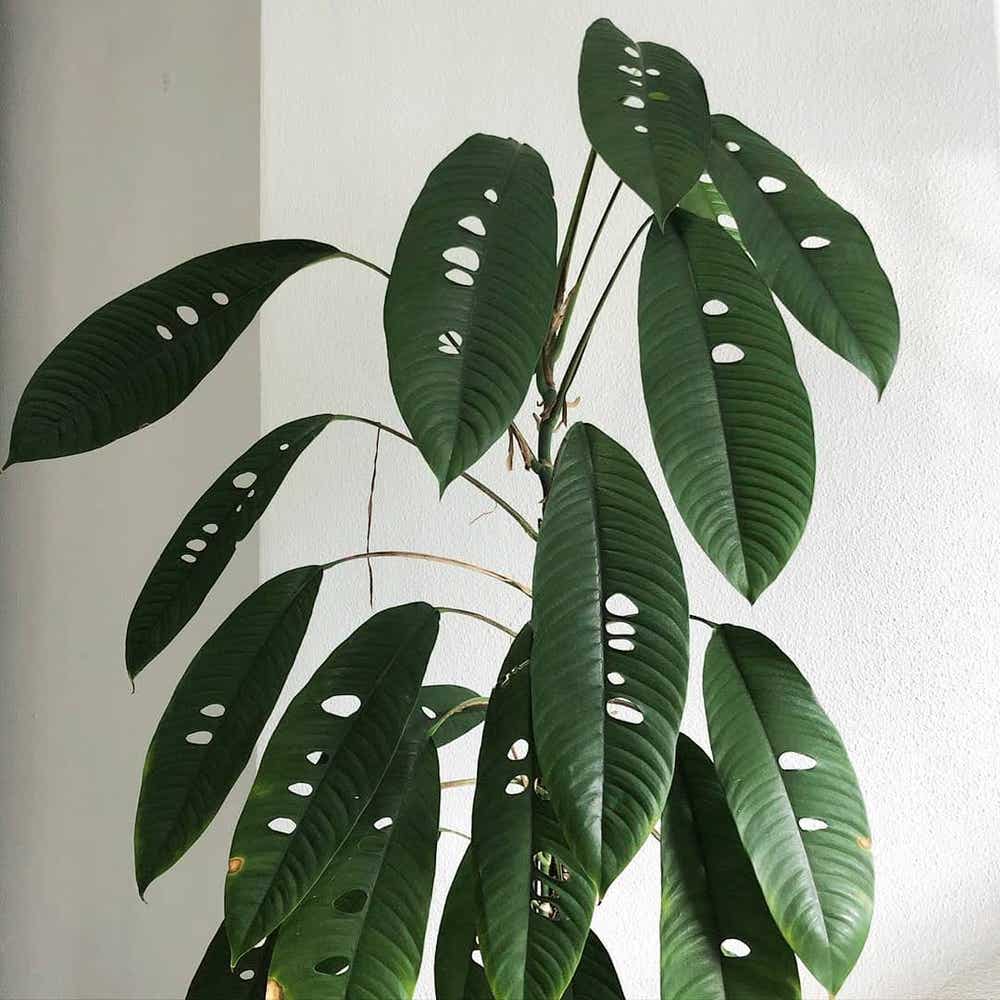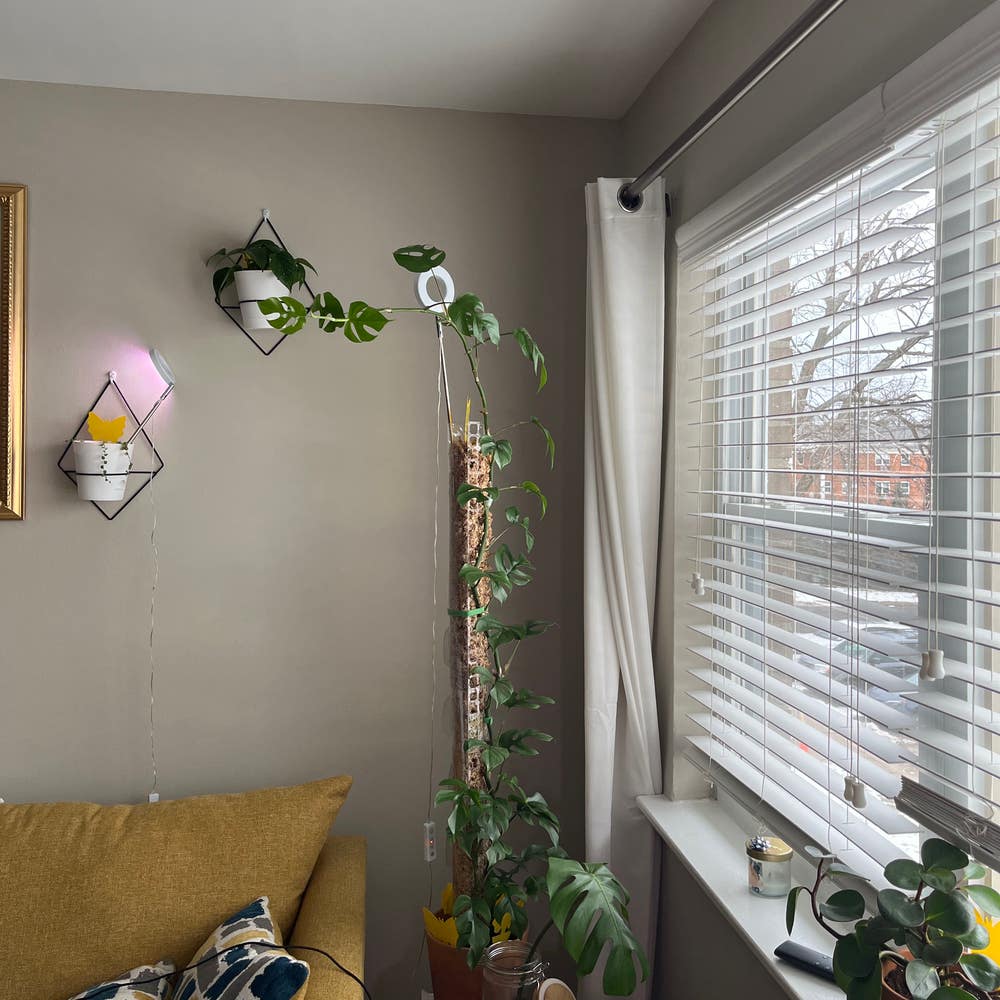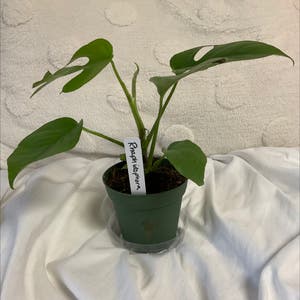




































Rhaphidophora foraminifera

4.5 out of 5 (2 experiences)
 Large, lush leaves
Large, lush leaves
 Fast grower
Fast grower
Taxonomy

Rhaphidophora foraminifera
Rhaphidophora
Araceae
Alismatales

How to care for Rhaphidophora foraminifera
How often to water your Rhaphidophora foraminifera

every 9
Rhaphidophora foraminifera needs 0.5 cups of water every 9 when it doesn’t get direct sunlight and is potted in a 5" pot.
Use our water calculator to personalize watering recommendations to your environment or download Greg for more advanced recommendations for all of your plants.

Water 0.5 cups every
9
Finding light for Rhaphidophora foraminifera in your home

a window
Rhaphidophora foraminifera may have difficulty thriving, and will drop leaves 🍃, without ample sunlight.
Place it less than 3 feet from a south-facing window to maximize the potential for growth.
Select your region to see how the current weather in your area affects the placement of Rhaphidophora foraminifera in your home 🏡.
How to fertilize Rhaphidophora foraminifera

Most potting soils come with ample nutrients which plants use to produce new growth.
By the time your plant has depleted the nutrients in its soil it’s likely grown enough to need a larger pot anyway.
To replenish this plant's nutrients, repot your Rhaphidophora foraminifera after it doubles in size or once a year—whichever comes first.
-
“I’m not going to buy plants this weekend” never seems to turn out that way does it….. Welcoming a #MiniMonstera #RhaphidophoraForaminifera and a #DwarfUmbrellaTree #Variegated #VariegatedDwarfUmbrellaTree to Grace’s Oasis 😅😅 Got these cutie pots this week and obviously needed to immediately fill them 🙄 #HappyPlants #PlantsMakePeopleHappy #PlantAddict #NewPlants #PlantHaul #MonsteraMob #UmbrellaTree #variegatedplants #Monstera
-
She’s growing so much I’ve had this mini monstera for 9 months and she’s gotten so big, almost six feet tall. But i’m noticing her new leaves are a bit smaller and she’s requiring A LOT more frequent watering which is causing gnats. Idk what to do with her or how to train her to hang or go back downward with the moss pole. ANY IDEAS 💡
-
My favorite plant is super happy! I see another root peaking at me!🖤 #HappyPlants #PlantsMakePeopleHappy #NewGrowth #RhaphidophoraTetrasperma
-
I put my mini monstera on a moss pole 11/29/23 and today I noticed an aerial root finally peaking! The feeling I had when I saw that root was almost (not quite as exciting but close) equivalent to when I held my oldest child for the first time almost 19 years ago. This is my first/only moss pole so far. #Acclimation #NewGrowth #HappyPlants #MossPole #TropicalPlants #MiniMonstera #RhaphidophoraTetrasperma #PlantsMakePeopleHappy
-
What should I do? My dragon's tail went through a bout with root rot. I had her in a pot that ended up being too big trying to accommodate the moss pole I had. I removed her, cut away her roots, and attempted to start over. But she's been drooping over since. Should I chop more? I don't want to lose her. 😔 #plantsmakepeoplehappy #plantaddict #dragontailplant
-
New leaves on my rhaph. tetrasperma :) do they always grow baby leaves with fenestrations?
-
Saw this beauty and had to grab her. Wasn’t expecting to find a mini Monstera at Walmart but sometimes you go in for something little and spot something great. My daughter got me the pot for Christmas and I was waiting for the right plant. I just love it! Brought it home… took it out of the self watering pot, put it in an airy, chunky soil mix and removed all the yellowing little leaves at the bottom. Popped in a pole since she has lots of aerial roots and she loooooks lovely 🥰 I named her mini because she’s stunning and fabulous like my daughter. It’s her “Mini me” #HappyPlants #PlantsMakePeopleHappy #MiniMonstera #Monstera
-
New addition Number 2 for today…a variegated #MiniMonstera! 🤯 #PlantsMakePeopleHappy #HappyPlants #Monstera #GregGang
-
New plant mom, well orchid grannie and expanded to plants. This is my new green housemate, couldnt resist he looked so fluffy. Question the window is SW how far away from the window does he need to be? Uk not sunny 😢 #MiniMonstera
-
I was wondering if you could help me identify what's wrong with my little monstera. I got her from a garden centre two weeks ago and it started spreading these brown spots.I repotted her when noticed in an airy mix.I think fungi? #MiniMonstera
Care Summary for Rhaphidophora foraminifera

Rhaphidophora foraminifera
 Greg recommends:
Greg recommends:
 Water
Water
0.5 cups every 9 days
 Placement
Placement
< 3ft from a window
 Nutrients
Nutrients
Repot after 2x growth
Based on the 4” pot your plant is in, and that it doesn’t get direct sunlight.

What other plant parents say
 Large, lush leaves 2
Large, lush leaves 2
 Fast grower 2
Fast grower 2
 Easy to propagate 1
Easy to propagate 1

 Trending in your area
Trending in your area
 Similar to Rhaphidophora foraminifera
Similar to Rhaphidophora foraminifera

Aglaonema

Alocasia 'Chantrieri'

Alocasia Dawn Variega…

Aglaonema

Aglaonema 'Green Bowl'

African Fantasy Thaum…

Alocasia Golden Lutea

Alocasia Amazonica Pi…

alocasia black zebrina

Alocasia 'Flying Squi…

Alocasia brancifolia

Aglaonema 'Treubii'

Alocasia Burle Marx A…

Aglaonema 'Super Whit…

Alocasia Dawn

Aglaonema 'Spring Sno…

Aglaonema 'Yellow Coc…
✨ Discover rare plants

Variegated Arrowhead …

Burro's Tail

Rosularia platyphylla

Munstead Lavender

Picasso's Paintbrush

Thelocactus macdowell…

Blushing Aeonium

Fernleaf Lavendar

Pink Ruby Sedevaria

Skeleton Key Pothos

Ruby Ball

Aglaonema 'Green Bowl'

Tuber Fleeceflower

Hoya 'Memoria'

Rainbow Echeveria

Tillandsia caerulea A…

Hoya 'Millie'






























